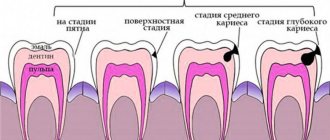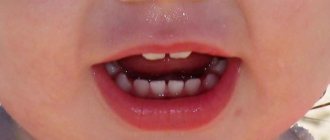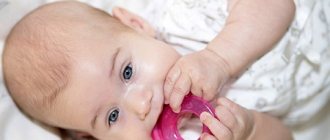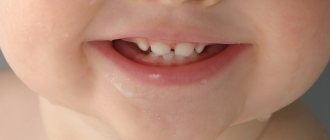What symptoms indicate that fangs are cutting?
Signs of the impending appearance of fangs appear in babies long before the moment when these teeth appear from the gums.
Usually, symptoms of their appearance are encountered 2-4 weeks before tooth eruption, but there are often situations when the fangs begin to bother the baby even earlier. In a child with teething teeth, parents will notice:
- Bad mood, irritability and moodiness.
- Excessive production of saliva, which can cause a cough or runny nose.
- Swollen and discolored gums in areas where the fang is expected. They turn red and become more prominent, after which a new tooth appears under the gum in the form of a white dot.
- Decreased appetite, and sometimes refusal to eat.
- Restless sleep, disturbed by soreness and burning in the gums.
- The desire to gnaw and chew on various objects so that they scratch the gums.
A pediatrician of the highest category, Mikhailova T.M., tells more about the symptoms.
Such symptoms are observed in many babies, but when fangs erupt, they are often accompanied by more unpleasant signs, including:
- Temperature rises to 37.5-38°C (less often up to 39°C) within 1-3 days.
- Loose stool, caused by excess saliva swallowed by the baby.
- Strengthening the gag reflex, which is also associated with a large amount of saliva in the toddler’s mouth.
- Rash on the chin due to the irritating effects of saliva.
The eruption of “eights” is usually accompanied by special symptoms. The following are most often identified:
- pain is felt in the area of the jaw joint and can vary in sensations (aching, sharp, throbbing);
- the gum becomes inflamed due to damage by a tooth;
- Temperature may occur during the eruption of wisdom teeth, and general health also worsens;
- a person begins to suffer from insomnia, difficulty chewing food, headaches;
- The submandibular lymph nodes (a kind of filters that cleanse the lymph from dangerous microbes) enlarge.
One of the unpleasant symptoms of teething may be submandibular lymph nodes.
Moderate manifestation of such symptoms is a normal process of wisdom teeth growth. It is recommended to sound the alarm only in case of too long tooth growth or acute manifestations of the mentioned signs. Smooth eruption of the third molar should, ideally, take place without a feeling of pronounced discomfort, so if you clearly sense a problem, contact your dentist.
What to expect
The first teeth appear at about 6 months of age. It may take 2 months from the moment the first signs appear until the tooth appears.
The following symptoms will help you understand that your baby is teething:
- before the teeth emerge, the gums look inflamed and swollen;
- salivation increases;
- the child begins to put all objects and toys into his mouth;
- eats poorly;
- sleep becomes interrupted, often wakes up crying.
Does not tolerate harsh sounds or bright light. There are sudden changes in mood: from apathy to an increased desire to be paid attention to.
Signs of teething that resemble the onset of a cold and bowel dysfunction:
- frequent regurgitation;
- the temperature rises to 38 degrees;
- bowel disorder (constipation or diarrhea);
- runny nose;
- cough;
- rash on cheeks.
It is not necessary that all these symptoms will be detected immediately. Some babies may only experience diarrhea, while others may simply drool. When the upper teeth come in, the temperature often rises.
During teething, especially the upper ones, the gums are injured. Therefore, you can see blood on it. It can change the smell of your mouth.
The danger posed by wisdom teeth
Wisdom teeth can cause a serious disease – pericoronitis. The soft tissue of the gums surrounding a tooth that has just begun to erupt or is already “mature” begins to become inflamed, which leads to pain when swallowing and chewing, fever, and poor health.
Attention! Pericoronitis is formed due to active bacterial microflora located under the gum hood of the “figure of eight”. This zone has the most favorable environment for the proliferation and habitat of dangerous bacteria.
Inflammation can lead to mechanical injury to the swollen area of the gum, the tissue of which covers the tooth. This is the reason for the formation of erosions and ulcers on it. In this case, a person may experience severe pain in the gums and cheeks.
Pericoronitis is an inflammation of the soft tissues of the gums during the eruption of wisdom teeth.
If you don’t catch it in time, after 2-3 days another form of pericoronitis appears - purulent. It is accompanied by pain in the posterior region of the seventh tooth (adjacent to the third molar). Additionally, pain manifests itself in the ear and temples. There are difficulties when swallowing, it is difficult to open the mouth. The temperature often rises during the eruption of wisdom teeth to 37.5 C.
Dangerous signs of the disease
Parents are often concerned about how their children's upper teeth are cutting. The fact is that the child’s upper gum is denser. Therefore, the process of teething is often more difficult than in the lower jaw. It may be accompanied by fever, diarrhea, and sometimes cough and runny nose.
The first sign that a child is cutting teeth, including the upper teeth, is increased drooling. In addition, during this period the baby puts everything into his mouth to “scratch” his gums. Parents can help him, ease his suffering. The inflamed area of the child's gum is lubricated with a special gel or drops, which have a cooling effect and reduce pain in the gum. You can moisten inflamed gums with a decoction of medicinal herbs such as sage, chamomile, and calendula.
An increase in body temperature is a fairly common symptom of teething in the upper teeth. This is especially typical for the time when the first upper tooth “climbs”. A child’s body temperature can rise to 37.7-38ºС. This is due to the fact that an inflammatory process occurs in the baby’s gums and intensive production of biologically active substances occurs.
Some children experience a significant increase in temperature when teething their upper teeth - up to 39ºC and higher. In this case, the child is given antipyretic medications, preferably paracetamol-based (Nurofen, Efferalgan). If the baby has a high temperature for more than 3-4 days and rises to high levels, he must be shown to a doctor. If a child experiences convulsions at a high temperature, his skin turns pale, and his breathing quickens, you should immediately call a doctor.
Diarrhea
The eruption of upper teeth in children is often accompanied by diarrhea. The appearance of diarrhea during the eruption of the upper canines is especially characteristic. This condition can be observed in a child for 2-3 days. In this case, the stool has a watery consistency, diarrhea repeats 2-3 times a day. It is important that there are no bloody or other inclusions in the baby's stool, as this may indicate the development of an infectious disease.
Teething diarrhea does not require any treatment; it goes away on its own after a few days. You just need to make sure that your baby gets enough fluids. In some cases, the doctor may prescribe the child Regidron solution and, if necessary, take medications containing beneficial bacteria.
Cough
In some children, the teething of the upper teeth may be accompanied by a wet cough, which worsens when lying down. A runny nose may also occur. These manifestations do not pose a threat to the baby’s health and disappear after 3-5 days. If the cough and runny nose do not go away on their own or are accompanied by other symptoms, the child should be shown to a pediatrician.
Teething, tooth growth and toothache in a child
For a child, as well as for his parents, the periods of teething and rapid growth of baby teeth can be very painful. During this period, you should redouble your attention to the baby, he desperately needs it.
Indeed, the eruption of baby teeth, which can last more than two years (from 6 months to 3 years), is a cause of great discomfort for children. This is also a discomfort for his parents, who sometimes do not know what to do to console and calm the baby and ease his suffering. This is further aggravated by the fact that the process of eruption of the first milk teeth occurs at an age when the child cannot yet speak. Therefore, we will dwell on the problem of teething and rapid growth of teeth and the accompanying pain, and also advise several ways to help the child cope with this.
Signs of rapid teething
The first stage of rapid eruption usually occurs at about 6 months of age, but in some children it occurs earlier, and in others almost at the age of 1 year. This process is accompanied by the following symptoms.
Mood
. A teething baby becomes more irritable than before. He cries more often and seems to grumble.
Night sleep
. Babies who used to sleep soundly through the night become restless when they start teething.
Physical symptoms
. Often, when teething, the temperature rises slightly, the cheeks and buttocks turn red, and salivation increases. Children may have looser stools than usual and may have poor appetite.
Non-dangerous concomitant diseases
. Because your baby becomes somewhat more vulnerable during teething, he may develop some minor illnesses, such as a runny nose. However, according to some experts, some symptoms accompanying the process of teething have a different origin. These symptoms usually appear immediately before the next tooth begins to erupt, but swelling and redness of the gums are always observed.
Which teeth hurt more when teething?
Some children experience the eruption of fangs very painfully, and eruption also occurs with anxiety when fours and fives appear. The teeth, coming out with their sharp edges, cut through the baby’s gum tissue, and therefore the child begins to be capricious and experiences discomfort when the gums begin to swell. The teething itself in a child occurs depending on his genetic parameters and biological age.
It is worth knowing that when the gums swell, a child may experience pain not only in the exact place where the tooth erupts, but in the entire mouth. A tooth may appear within a month, or maybe after two months it will not even appear on the surface of the gum. These are all individual characteristics of your baby, and you should not be upset if, with constantly inflamed gums and increased salivation for more than a month, teeth have not appeared.
1. The growth of the “eight” in the wrong direction The third molar should grow, like all other teeth - upward. However, it often changes its direction and rushes in other directions - to the right, left, down. This way it rests on the jawbone or adjacent teeth.2. Displacement of the dentitionDisplacement of the dentition occurs due to lack of space for the eruption of the “eight”.
Toothache can be caused by many factors, some of them are misalignment of the dentition, caries, incorrect placement of the “eight” during teething.
3. The appearance of caries The wisdom tooth is located in a place that is difficult to reach for cleaning. Poor hygiene leads to tooth decay. It often occurs due to slow growth of the molar.4. Inflammatory process All the mentioned inflammatory processes lead to severe pain. It is very important to warn her in time.5.
Pain syndrome during teething
Often pain during the eruption of fangs is associated with swelling of the gums. First, white dots appear on the gums - the edge of the tooth is visible. Then they swell and redness appears. This is an absolutely normal and natural process.
Pain during teething can be a manifestation of not only swelling of the gums, it can also be pain in the ears and nose.
It is important to pay attention to this and consult a doctor if such symptoms occur, so as not to confuse the eruption of fangs with an inflammatory process. This is manifested by the fact that the child cries and at the same time reaches for his ears and nose, involuntarily rubbing them.
Watery eyes and conjunctivitis
When the upper canines, also called “eye teeth,” come out, the child sometimes experiences involuntary lacrimation.
This is due to the nerves that run near the roots of the upper canines, they provide communication between the central nervous system and the facial muscles.
If a child rubs his eyes frequently, he may get an infection and this will lead to conjunctivitis. In such cases, special eye drops are selected. Conjunctivitis should be treated under the close supervision of doctors.
The eruption of the lower canines is not accompanied by these symptoms and causes less trouble.
Gastrointestinal problems and teething
Ideally, there should be no problems with digestion during teething. But often the child may experience diarrhea or, on the contrary, constipation. This is due to stress during teething.
If a child has been constipated for less than three days and his behavior has not changed in any way, and his tummy is soft, then there is nothing dangerous in this condition.
To eliminate constipation, it is worth reviewing the baby’s diet, introducing vegetable purees and fresh juices into complementary foods, increasing physical activity, doing massage and exercises. But if a child experiences bloating, constipation for more than three days, or a fever, then an urgent need to consult a doctor.
Diarrhea during the eruption of fangs is a frequent and more dangerous phenomenon. High salivation and the entry of microbes into the body lead to liquefied stools. This symptom should be treated very carefully.
Diarrhea should not recur more than once every two days. Often this is a manifestation of dangerous intestinal infections. Alarm signals include:
- Repeated bowel movements more than 5 times a day
- Loose stools with pain
- Bloody discharge, inclusions in stool
- Color change
- Diarrhea does not stop for 3 days
If a child exhibits one of these symptoms, is this a reason to urgently call a doctor? YES!
Increased salivation and rash
This seemingly normal physiological phenomenon during teething can also carry some danger. A large amount of saliva can cause a gag reflex or severe coughing if it enters the nasopharynx.
This sometimes happens in a dream if the child sleeps on his back.
Rashes may appear on the child's chin in response to the irritating effects of saliva. To prevent rashes, it is worth treating your child’s chin with baby cream more often.
Age and timing of canine eruption
Fangs are those teeth that erupt after one year.
According to statistics, the average age at which fangs begin to erupt is 16-18 months; they usually erupt after or together with the molars. But this is not always the case, each child is individual, there is no specific norm. Everything is absolutely conditional.
The age of canine eruption can vary ±4 months or more. Typically, fangs erupt within 3 days.
But it happens that the first symptoms appear before the due date or the fangs are cut at the same time as other teeth, then the period of eruption of the fangs looks slightly prolonged.
Your pediatrician will tell you how to distinguish teething symptoms from signs of illness.
Are you worried about your baby crying all the time? Questions are always running through your head, for example: “When do babies start teething?”, “How long will it take?” and “How painful will this process be?” Don't worry as every mother goes through this. There is no fixed pattern for teething and the process will be different for each baby.
Teething is the process where a baby's baby teeth emerge through the gums. Many parents are naturally concerned about the pain their baby may be experiencing. Knowing the first signs of teething will help you prepare for this stage of development.
Rules for oral hygiene in children
How to properly care for your oral cavity during teething?
It is necessary to clean your mouth even before teeth appear. The mother should wrap a sterile gauze cloth around her finger and gently wipe the baby's gums. You can use special finger pads for baby hygiene, which are made of soft hypoallergenic material. By the time your baby is one year old, you can buy a toothbrush and toothpaste. Hygiene products must be suitable for children; the use of adult toothpastes is prohibited. When choosing a toothpaste, you need to look at the packaging and the presence of markings indicating age restrictions. Children's pastes are low-abrasive and do not damage enamel; instead of fluoride, they contain calcium and can be swallowed.
Until the age of 4, it is recommended that parents brush their children's teeth themselves. To do this, you need to buy a toothbrush with a small head and a long, thin handle. The bristles should be soft and short.
Proper oral care is the key to healthy teeth. Cleaning your teeth and gums will help prevent tooth decay and gum disease.
Read also: Wisdom tooth is growing, gums are swollen
When should you worry if your child’s teeth are not cutting?
The average age for teething to begin is about six months. The appearance of teeth before six months is considered early. If a baby has no teeth before 13 months, this is considered a delay.
Don't worry if teething is delayed; it varies from one child to another. As long as your baby's hair, skin and bones are in good condition, there is nothing to worry about. Delayed teething does not indicate any problem in the overall development of the child.
The appearance of teeth may be delayed due to:
- hereditary factor;
- poor nutrition;
- hypothyroidism (thyroid disease);
- premature birth.
However, if you believe that there is no hereditary cause and the child is receiving adequate nutrition and teeth are not appearing, then you should consult a doctor. But first, pay attention to the signs that will tell you when a tooth might appear.
Symptoms
The level of pain a baby feels will be different for each baby. Some babies may suffer more than others when they are teething. Soreness and swelling of the gums before the tooth emerges are the cause of the discomfort the baby experiences during this change. These symptoms usually begin approximately three to five days before the tooth emerges, and they disappear when the tooth breaks through the gum.
Signs of teething:
- Salivation. A teething baby tends to drool more than at other times as tooth advancement and pain force him to hold his mouth open for longer periods of time. You will end up drooling more than usual. A mild rash may develop due to irritation of the skin around the mouth caused by excessive drooling. If you notice that your baby's clothes are constantly damp, attach a baby bib and gently wipe his chin throughout the day.
- Biting. The pressure of teeth pushing under the gums leads to severe discomfort, which can be relieved by applying pressure from the opposite side (chewing and biting). Teething babies will chew on anything they find, from special toys and rattles to their mother's nipples when breastfeeding and fingers.
- Irritation. Sore gums and teething cause discomfort and you will find that your baby gets irritated too easily and is fussy most of the time.
- Swelling of the gums. When teeth cut, they usually cut through the gums, causing them to swell. If a baby's gums are swollen and painful, this is a sign that a new tooth will soon grow.
- Grabbing ears. Another sign of pain; the pain in the mouth radiates throughout the child's head, so they pull their ears, assuming that this will lead to relief.
- Crying, restless sleep at night and mild fever are also associated with teething. Babies may even refuse to eat due to pain.
- Teeth visible inside the gums. The most obvious sign that babies are teething is when they appear along the bottom of the jaw.
Symptoms usually resolve on their own, but your doctor should be notified if they worsen or persist. Teething may cause symptoms in the mouth and gums, but the process does not cause problems in other parts of the body.
How to distinguish symptoms of teething from signs of disease?
This is likely an illness if your child:
- is overly fussy that you can't calm him down. The phrase "teething" makes you think that the baby will have unbearable pain, but it is quite mild. A little extra fuss is okay. But, if your child cries so much that he cannot sleep or calm down, consult a doctor;
- has a high temperature. A fever of 38°C or higher likely indicates an infection.
- refuses any food (solids and liquids). Some children avoid hard foods when a new tooth emerges. But if your baby also refuses to breastfeed or put a bottle in his mouth, talk to your pediatrician;
- has a runny nose, cough, vomiting or diarrhea. There is no evidence that teething causes any of these problems. Most likely, these manifestations indicate that the child is sick;
- has a rash not only on the face. Often excessive drooling results in a rash around the mouth, but if the rash spreads to the torso, arms or legs, it may be due to illness;
- symptoms last more than a few days. Irritability, swollen gums and a slightly elevated temperature can be caused by teething, but only in the days before and after the tooth appears.
So if your child feels unwell for several days in a row and you still can't see the tooth, something else is probably bothering your baby.
Pediatricians explain that the child’s passive immunity from maternal antibodies disappears at this time, and the baby is exposed to a wide range of pathogens. Thus, it is likely that the child's vomiting or diarrhea has a different etiology.
Remedies for pain relief in children
It is painful for parents to see their child in pain. You can help him get some relief with these remedies:
- Often, pain in the gums is relieved by gentle pressure on them. Therefore, many experts advise gently rubbing the gums with a clean finger or letting the child bite on a clean cloth.
- If pain is causing feeding problems, sometimes a different shaped nipple or using a cup can reduce discomfort and improve feeding.
- Cold objects can also help reduce inflammation. Using special teething rings can be helpful. Experienced parents have found that using a cool, damp sponge, a cold pacifier, a spoon, or frozen bananas can be effective in reducing discomfort. Avoid prolonged contact of excessively cold objects with your gums. Also, never place objects that may cause choking (small parts) into your child's mouth.
- Use of painkillers. There is controversy surrounding the use of these products during teething:
- Although some parents approve of topical medications, studies have not always shown their benefit. In May 2011, the FDA issued a warning to avoid topical medications containing an anesthetic called benzocaine. Benzocaine is the main ingredient found in many over-the-counter gels and sprays. The FDA warning indicates a link to a rare but extremely dangerous complication called methemoglobinemia. In this condition, the ability of red blood cells to deliver oxygen throughout the body is significantly limited, which can lead to serious consequences and even death. Children with methemoglobinemia experience pallor, shortness of breath, and increased heart rate. This reaction may occur on first use or after several exposures to benzocaine. A child with these symptoms should be taken to the emergency department of the nearest hospital;
- Systemic medications such as paracetamol or ibuprofen will also help with pain. Check with your pediatrician regarding the use of these and other medications. Care should be taken not to overdo them in their use. The medicine may mask important symptoms that may be necessary to understand the child’s condition;
- Homeopathic remedies and other folk methods are widely used, there is limited research into their true effectiveness. Using clove oil, licorice sticks, fennel, scallions, olive oil, ginger root and chamomile can be effective.
Timing of teething in babies
Babies' first milk teeth appear at the age of 6-7 months. The lower incisors erupt first, followed by the upper incisors after 3-6 weeks. The upper and lower lateral incisors grow between the ages of 9 and 12-13 months. The growth of fangs occurs closer to 1.6-2 years. Molars are the last to be born. The teething process is completed by the age of 3 years.
| Four - seven months | Central lower incisors |
| Eight - twelve months | Central upper incisors |
| Nine - sixteen months | Lateral lower and upper incisors (next to the middle teeth) |
| One year | The baby has a set of eight teeth |
| Thirteen to nineteen months | First molars (two above and below) |
| Sixteen to twenty-three months | Fangs (two on top and bottom) |
| Twenty-three to thirty-one months | Second molars (lower teeth appear first, then upper teeth) |
| The numbers indicate the order in which baby teeth appear | Average age of teeth | |
| Lower central incisors (1) | 6-7 months | |
| Upper central incisors (2) | 8-9 months | |
| Upper lateral incisors (3) | 9-11 months | |
| Lower lateral incisors (4) | 11-13 months | |
| Upper small molars (molars) (5) | 12-15 months | |
| Lower small molars (molars) (6) | 12-15 months | |
| Upper canines (7) | 16-18 months | |
| Lower canines (8) | 18-20 months | |
| Lower large molars (molars) (9) | 24-30 months | |
| Upper large molars (molars) (10) | 24-30 months | |
Often, teeth appear according to individual timing. Parents don't need to worry. A deviation from the norm of 1-2 months is not a pathology. If the schedule changes significantly, the help of a doctor is necessary. The examination begins with a pediatrician and dentist.
Causes of early or late appearance of teeth in infants:
- genetic predisposition. If the baby is already 8 months old and there are no signs of teething, talk with relatives. Perhaps the late appearance of teeth is a variant of the family norm;
- lack of vitamins;
- metabolic disease;
- pathology of the thyroid gland;
- rickets.
Sometimes babies are born with teeth already erupted. Incisors that grow before birth are called natal, and those that appear between 1 and 3 months of life are called neonatal.
Prematurely erupted teeth cause inconvenience to babies and their mothers. When feeding, the baby systematically injures the mucous membrane of the frenulum of his own tongue, bites and injures the mother's breast. Congenital teeth have increased mobility. As a result, there is a risk of premature loss of the incisor and aspiration of the baby by a foreign body.
Incisors are complex (primary milk) and spare (additional). If the primary primary incisors are removed prematurely, the formation of the jaw bones will be disrupted in the future and occlusion pathology will occur. Therefore, it is recommended to preserve complex teeth.
Additional incisors are flexible and fall out on their own for the first 2-6 weeks of a baby’s life. More often, with the consent of the parents, spare teeth are removed, as they cause inconvenience and interfere with the growth of full-fledged milk teeth.
What to do with natal and neonatal teeth is decided jointly by the pediatrician and the dentist.
When do teeth begin to appear and until how many years do they change to permanent ones?
How many months do teeth start cutting?
The date of appearance of teeth, like other statistical information, is determined approximately rather than accurately. It all depends on the individual characteristics of the child: some become a “nibbler” much earlier than expected, others later. Boys are slightly behind girls. On average, children begin to erupt teeth at this age:
| Teeth | Age of appearance, months | When teeth fall out, yo |
| Top row | ||
| central incisors | 8-12 | 6-7 |
| lateral incisors | 9-13 | 7-8 |
| fangs | 16-22 | 10-12 |
| first molars | 13-19 | 9-11 |
| second molars | 25-33 | 10-12 |
| Bottom row | ||
| central incisors | 6-10 | 6-7 |
| lateral incisors | 10-16 | 7-8 |
| fangs | 17-23 | 9-12 |
| first molars | 14-18 | 9-11 |
| second molars | 23-31 | 10-12 |
Teething symptoms
It is impossible to miss the moment when babies' teeth appear.
There are a small number of cases in the world when teething proceeded unnoticed. Much more often, the moment of growing up is accompanied by a number of unpleasant signs. Harbingers of the appearance of teeth:
- decreased mood of the toddler. The child becomes irritable, capricious, and looks lethargic. Parents notice that babies require increased attention. Until one year old, children cannot speak; they express feelings in the form of crying;
- itchy gums. Babies put their fists in their mouths, suck on toys and items of clothing;
- gum hyperemia. When the sharp part of the tooth erupts, drops of blood appear on the swollen mucous membranes;
- refusal of complementary foods. Eating food is accompanied by unpleasant sensations. As a result of this, the baby's appetite decreases;
- increased salivation, the appearance of reflex cough, vomiting;
- stool liquefaction;
- rhinitis;
- increase in body temperature.
Video with recommendations from a dentist:
Fever, diarrhea, vomiting, cough may indicate an infectious disease. If your baby's health worsens sharply, do not treat the baby yourself. Up to a year, pathologies develop rapidly and cause severe complications. Most often, young parents are not able to make the correct diagnosis on their own. Do not risk your child’s health - call a pediatrician for a consultation.
Signs of teething
How do you know when your baby is starting to teethe? This question is partly rhetorical. It is impossible to judge by the baby’s condition alone. It is possible to say for sure that the baby’s incisors begin to erupt only when the first tooth appears. However, it is worth paying attention to some points. How do children cut teeth? The first signs of cutting will appear in the baby's mouth. It is necessary to pay attention to the child's gums. If they are red and swollen, you can expect the first teeth to appear soon.
During teething, the child's immunity decreases significantly. Therefore, more alarming symptoms may appear, such as increased body temperature, redness of the throat, diarrhea, cough, etc. At this time, it is not advisable to visit public places with the child. The baby's body should get stronger. It is also undesirable to vaccinate at a time when the baby is erupting his first tooth. The outcome of medical intervention can be unpredictable. A child’s poor health cannot always be attributed to teething. You definitely need to call a pediatrician at home. The specialist will make an accurate diagnosis and tell you how to avoid complications.
Helping your baby with teething
Milk teeth are equipped with a pointed crown. With its help, incisors, canines and molars cut through the thickness of soft tissue. During the period of teething, the well-being of toddlers deteriorates sharply. You can alleviate the condition of your beloved baby by following simple rules:
- Walking is an essential part of a child’s life. Babies sleep well in the fresh air. If the baby is capricious and does not want to lie quietly in the stroller, take a walk down the street, carrying him in your arms. The optimal place to hang out with children is park and coastal areas;
- Compliance with the temperature regime in the room (18-20 ° C), the absence of excess clothing on the child;
- Tactile contact is important for the baby and parents. During teething, the baby needs attention. Hug, kiss the baby more often, carry in your arms. Children after a year are quickly distracted from unpleasant sensations if their parents read picture books and play educational games;
- Keeping your child's toys clean;
- Using teethers helps relieve itching in the gums and reduce pain. Useful toys are made from silicone, rubber, plastic, rubber, and have a variety of shapes and colors. Water-filled teethers are popular. Before use, the toy must be placed in the refrigerator. Specialized children's products are purchased in stores and pharmacies. There are strict requirements for purchasing teethers: safety (no Bisphenol A), hypoallergenic, integrity, strength. Pediatricians advise giving preference to well-known brands: Canpol (Canpol), Happy Baby (Happy Baby), NUK (Nuk), Philips Avent (Philips Avent);
- Treating the nose with a saline solution will relieve the upper respiratory tract of accumulated mucus and restore proper breathing. Medicines for children: Aqualor, Aqua Maris, Quix;
- Careful oral hygiene will protect against inflammatory processes in the gum area. The treatment is carried out by the parents. Up to a year, use a special toothpaste and a silicone toothbrush - a fingertip. Soft bristles do not injure the gums, but have a massage and analgesic effect.
If your baby has a fever, call a doctor at home. The pediatrician will conduct an examination and identify the cause of the ailment. For fever above 38.5 °C, antipyretic drugs Paracetamol or Ibuprofen are used.
How to help your baby and reduce painful symptoms?
Children's eye teeth erupt very painfully. No parent can stand by and watch their child cry. How to help a baby and ease his suffering when fangs are cutting on top? There are such remedies; special teethers have been developed for children, as well as medications that anesthetize the gums, relieve swelling and relieve inflammation.
Read also: How long does anesthesia last after dental treatment?
Special teethers and pacifiers
Pharmacies sell special teethers that are designed to relieve itching and relieve pain during teeth growth. They are painted in bright colors and have a regular, orthodontic shape, and inside are filled with liquid and cooling gel.
When a baby sees a new toy, he will definitely try to chew it. The hypoallergenic material is pleasant to the touch and children enjoy biting it. Thus, they eliminate itching from the eruption of baby teeth, and the anesthetic gel relieves pain. Teethers should be stored in the refrigerator, so they will have a greater effect, because cold relieves swelling well and reduces irritation.
Massaging the gums helps a lot. With clean hands, gently massage the gums, alternating pressing, circular and stroking movements. If the baby starts sucking his finger at the moment of teething, you should not scold him for this habit, it helps the baby get rid of pain. Gradually you need to replace your finger with a teether or pacifier.
Medications
If the growth of an eye tooth is accompanied by severe pain, it is impossible to get rid of it with the help of pacifiers and pacifiers. For this purpose, pharmacies sell dental gels and ointments designed to numb the inflamed area. You can buy medications to facilitate teething only after consulting a dentist.
The table provides a list of medications suitable for easing teething:








